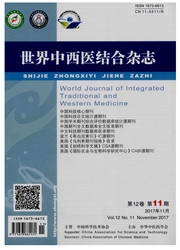
欢迎您!东篱公司
退出

 中文摘要:
中文摘要:
运用频数、决策树和神经网络等统计学方法,对发放于全国六大地区临床第一线专家大样本的冠心病中医证候要素、证候特征及证候病机演变规律调查问卷的调查结果,进行统计学分析,结果显示冠心病的主要证候要素为寒、痰、气、瘀、虚等,其中“气滞”这一证候要素贯穿冠心病病变的始终,说明“气滞”在冠心病发病和发展的过程中起着重要的作用。
 英文摘要:
英文摘要:
Statistical methods such as frequency, decision tree and neural networks have been applied to analyze the CAD main TCM syndromes,syndrome features and pathogenic development of syndromes from the questionnaires distributed to clinical experts in six major areas of China. The results showed that TCM syndromes were mainly cold, phlegm,qi, blood stasis, asthenia and so on. Qizhi as one of them permeated though the development of CAD,which implied Qizhi played an important role in the occurrence and development of CAD.
 同期刊论文项目
同期刊论文项目
 同项目期刊论文
同项目期刊论文
 期刊信息
期刊信息
